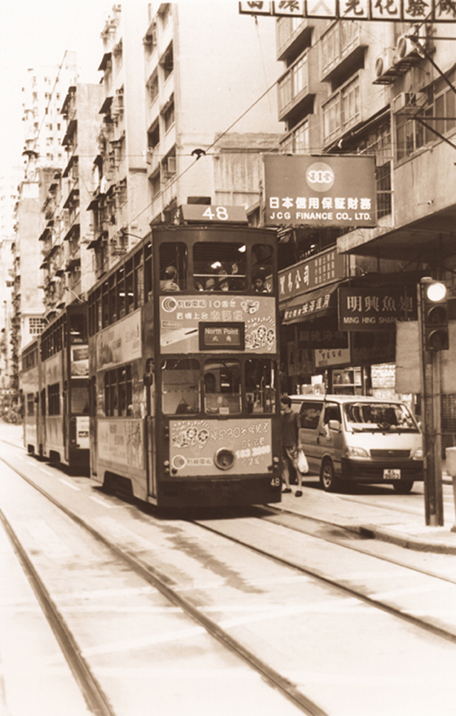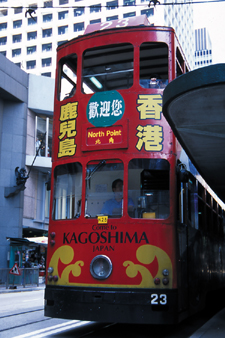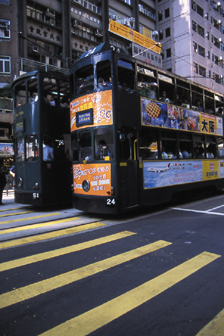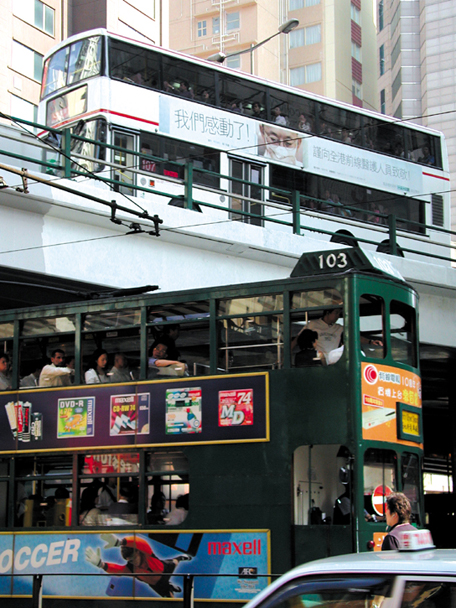Tramways
A unique witness to Hong Kong history
Photos & text by Cherry Cheung, Eric Tsang, Lei Xuan & Penelope Yau
Hong
Kong Tramways has been serving the city since 1904.
(Penelope Yau)
Imagine a picture of a bronze wire spider web entangled among tree trunks in a concrete jungle. Giant wooden beetles jog under the shadows in slits created by sunlight through the glass canopy. This is a verbal portrait of trams in Hong Kong.
Hong Kong’s trams are rolling antiques. They are unique not only to Hong Kong, but to the world. Tram services were first proposed in Hong Kong in 1881. However, at that time, nobody was willing to invest in the system, and the proposal was not approved by the government until 1901.
Construction of the tramway system commenced in 1903. The single-track tramway, which connected Wan Chai, Happy Valley and Shau Kei Wan, featured its first journey on 30 July 1904. Since then, it has not interrupted service, except during the Japanese occupation of Hong Kong during World War II.
The tram route begins in Kennedy Town, crossing the salted fish market in Connaught Road. It then clanks its way from the Edwardian-style Western Market, by the neo-classical Legislative Council Building, and on to the stone lion statue at Tin Hau Temple.
Ding ding ding. Trams, or “ding dings” — the nickname for trams known by all Hongkongers — sound their bells frequently as they trundle along. This soft, light sound contrasts with the bullying motor-horns of the other vehicles on the road.
Trundling along Happy Valley to the hustle and bustle of Central, the tram unifies the multi-dimensional community on Hong Kong Island.
Spending 80 minutes on a full ride from Kennedy Town to Shau Kei Wan is far more interesting than a Hong Kong geo-history lecture.
In its early days, the tram fleet was made up of 26 single-deck trams.
Imported from England, the cars were 29 feet long and 6 feet, 1 inch wide. Due to the increase in demand for tram services, double-deck trams were introduced in 1912. Throughout the years, Hong Kong’s tramcars have developed into the world’s largest fleet of double-deck trams. The number of double deck trams in Hong Kong now stands at 163. This includes two antique trams.
Because of the panoramic view passengers get from the upper deck, upper deck fares used to be more expensive than the lower deck’s.
However, fares for both decks have since been standardized. Adults pay $2, while children under 12 and senior citizens aged 65 or older pay $1. Monthly tickets are also available.
Three new trams with electronic speedometers, air-conditioning, and more comfortable seating were added to the fleet in 2000.
The trams
are colorful reminders of times gone by. As spider webs are to spiders,
trams are irreplaceable icons of Hong Kong.


Left:
Two trams standing at a zebra-crossing.(Cherry Cheung)
Right:A tram stops for passengers to board. (Lei Xuan)

The gentle ‘ding ding’ of trams contrasts with the
bullying motor-horns of other vehicles on the road. (Eric Tsang)